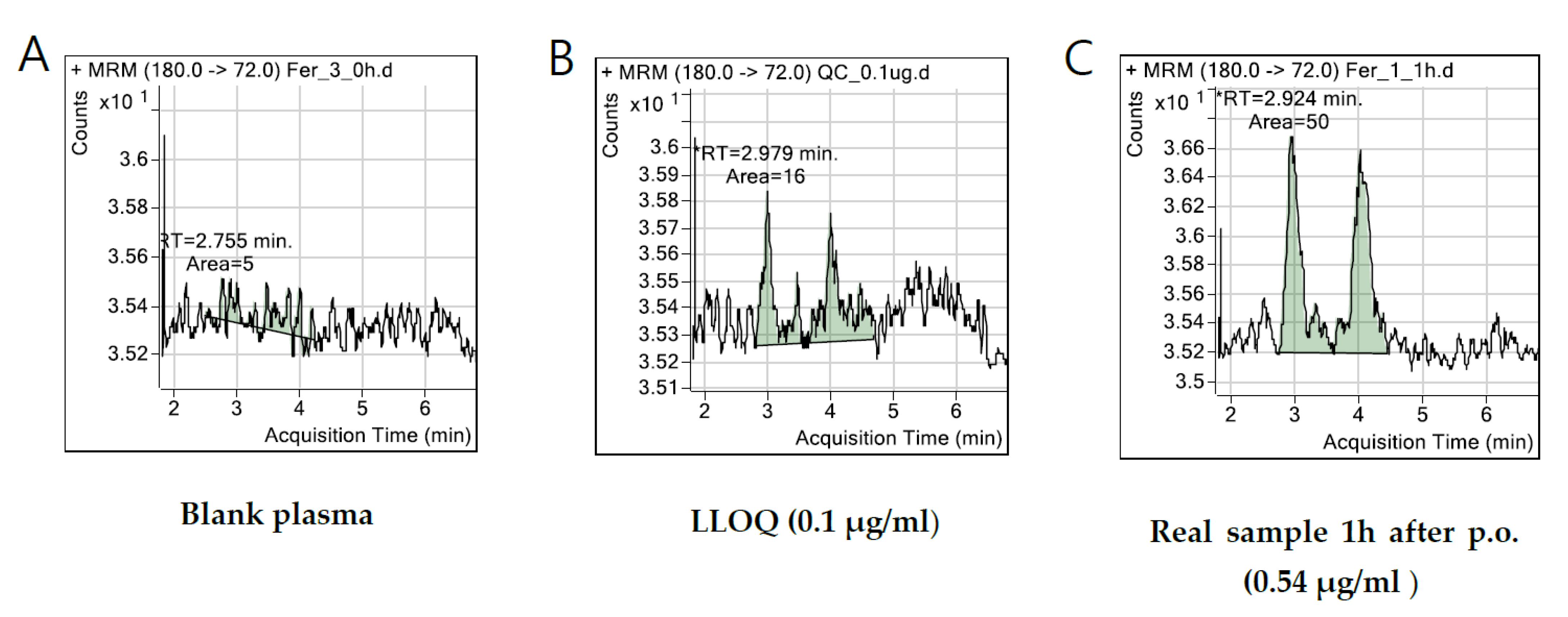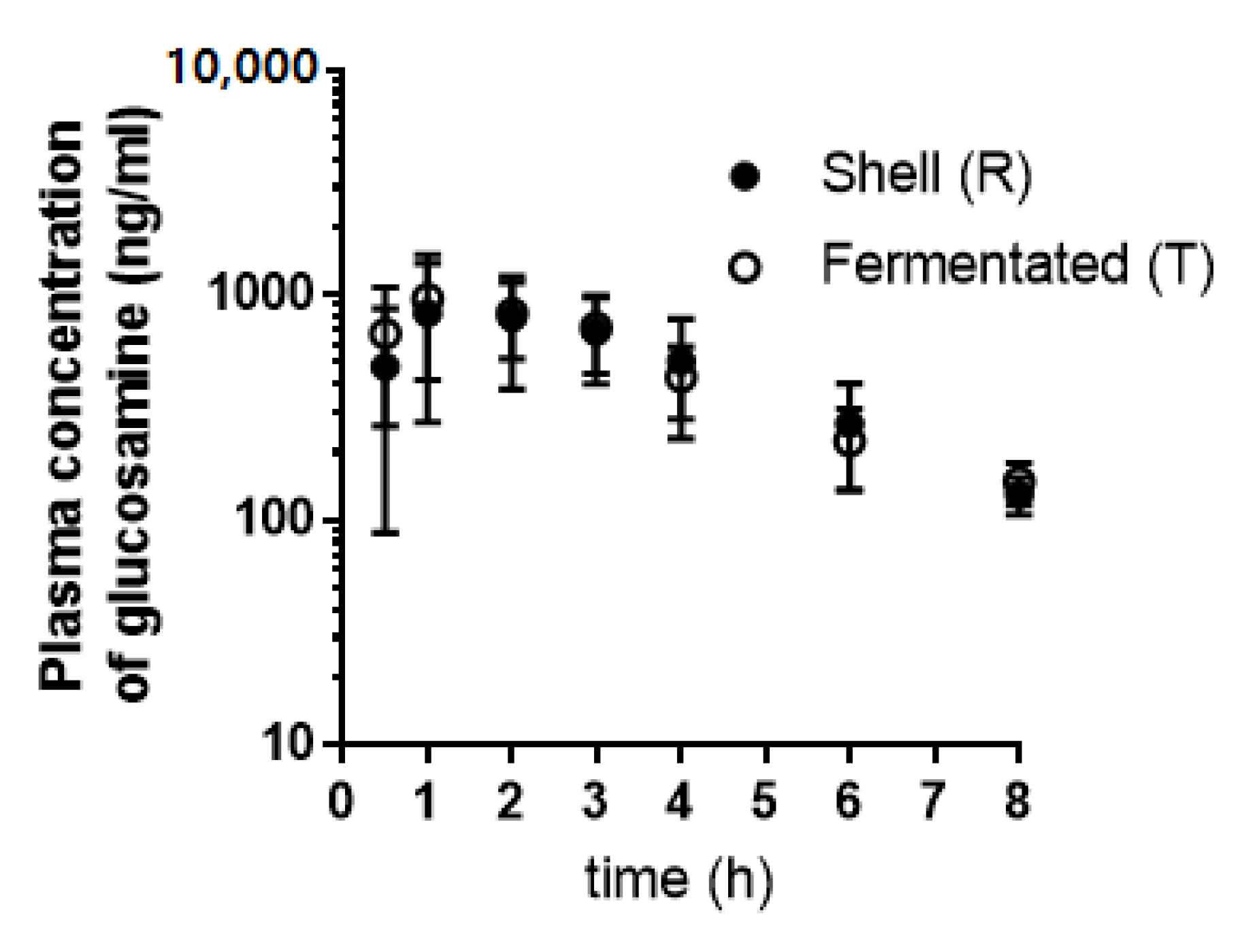Pharmacokinetic Comparison of Chitosan-Derived and Biofermentation-Derived Glucosamine in Nutritional Supplement for Bone Health
Abstract
1. Introduction
2. Materials and Methods
2.1. Study Design and Subjects
2.2. Glucosamine Sample Preparation
2.3. LC-MS/MS Analysis of Glucosamine
2.4. Pharmacokinetic and Statistical Analysis
3. Results
3.1. Subject Characteristics
3.2. Pharmacokinetic Data for Plasma Glucosamine in Subjects
4. Discussion
5. Conclusions
Author Contributions
Funding
Institutional Review Board Statement
Informed Consent Statement
Acknowledgments
Conflicts of Interest
References
- Hamerman, D. The Biology of Osteoarthritis. N. Engl. J. Med. 1989, 320, 1322–1330. [Google Scholar] [PubMed]
- Conrozier, T.; Lohse, T. Glucosamine as a treatment for osteoarthritis: What it it’s true? Front. Pharmacol. 2022, 17, 820971. [Google Scholar] [CrossRef] [PubMed]
- Kanzaki, N.; Ono, Y.; Shibata, H.; Moritani, T. Glucosamine-containing supplement improves locomotor functions in subjects with knee pain: A randomized, double-blind, placebo-controlled study. Clin. Interv. Aging 2015, 10, 1743–1753. [Google Scholar] [CrossRef] [PubMed]
- Zeng, C.; Wei, J.; Li, H.; Wang, Y.L.; Xie, D.X.; Yang, T.; Gao, S.G.; Li, Y.S.; Luo, W.; Lei, G.H. Effectiveness and safety of Glucosamine, chondroitin, the two in combination, or celecoxib in the treatment of osteoarthritis of the knee. Sci. Rep. 2015, 5, 16827. [Google Scholar] [CrossRef] [PubMed]
- Reginster, J.Y.; Deroisy, R.; Rovati, L.C.; Lee, R.L.; Lejeune, E.; Bruyere, O.; Giacovelli, G.; Henrotin, Y.; Dacre, J.E.; Gossett, C. Long-term effects of glucosamine sulphate on osteoarthritis progression: A randomised, placebo-controlled clinical trial. Lancet 2001, 357, 251–256. [Google Scholar] [CrossRef]
- Kloppenburg, M.; Berenbaum, F. Osteoarthritis year in review 2019: Epidemiology and therapy. Osteoarthr. Cartil. 2020, 28, 242–248. [Google Scholar] [CrossRef]
- Zhang, H.; Lu, Y.; Wang, Y.; Zhang, X.; Wang, T. d-Glucosamine production from chitosan hydrolyzation over a glucose-derived solid acid catalyst. RSC Adv. 2018, 8, 5608–5613. [Google Scholar] [CrossRef]
- Marra, C.A.; Harvard, S.; Grubisic, M.; Galo, J.; Clarke, A.; Elliott, S.; Lynd, L.D. Consumer preferences for food allergen labeling. Allergy Asthma Clin. Immunol. 2017, 13, 19. [Google Scholar] [CrossRef]
- DeSalvo, J.C.; Skiba, M.B.; Howe, C.L.; Haiber, K.E.; Funk, J.L. Natural Product Dietary Supplement Use by Individuals with Rheumatoid Arthritis: A Scoping Review. Arthritis Care Res. 2019, 71, 787–797. [Google Scholar] [CrossRef]
- Faul, F.; Erdfelder, E.; Lang, A.G.; Buchner, A. G*Power 3: A flexible statistical power analysis program for the social, behavioral, and biomedical sciences. Behav. Res. Methods 2007, 39, 175–191. [Google Scholar] [CrossRef]
- Akarasereenont, P.; Chatsiricharoenkul, S.; Pongnarin, P.; Sathirakul, K.; Kongpatanakul, S. Bioequivalence study of 500 mg glucosamine sulfate in Thai healthy volunteers. J. Med. Assoc. Thai. 2009, 929, 1234–1239. [Google Scholar]
- Zhong, S.; Zhong, D.; Chen, X. Improved and simplified liquid chromatography/electrospray ionization mass spectrometry method for the analysis of underivatized glucosamine in human plasma. J. Chromatogr. B Analyt. Technol. Biomed. Life Sci. 2007, 854, 291–298. [Google Scholar] [CrossRef]
- Song, M.; Hang, T.J.; Wang, C.; Yang, L.; Wen, A.D. Precolumn derivatization LC-MS/MS method for the determination and pharmacokinetic study of glucosamine in human plasma and urine. J. Pharm. Anal. 2012, 2, 19–28. [Google Scholar] [CrossRef]
- US FDA/Center for Drug Evaluation and Research. Guidance for Industry: Bioanalytical Method Validation. 2018. Available online: https://www.fda.gov/files/drugs/published/Bioanalytical-Method-Validation-Guidance-for-Industry.pdf (accessed on 24 May 2018).
- Chiou, W.L. Critical evaluation of the potential error in pharmacokinetic studies of using the linear trapezoidal rule method for the calculation of the area under the plasma level-time curve. J. Pharmacokinet. Biopharm. 1978, 6, 539–546. [Google Scholar] [CrossRef]
- Department of Health and Human Services, US FDA/Center for Drug Evaluation and Research. Guidance for Industry: Statistical Approaches to Establishing Bioequivalence. Available online: https://www.fda.gov/media/70958/download (accessed on 7 June 2022).
- Wu, H.; Liu, M.; Wang, S.; Zhao, H.; Yao, W.; Feng, W.; Yan, M.; Tang, Y.; Wei, M. Comparative fasting bioavailability and pharmacokinetic properties of 2 formulations of glucosamine hydrochloride in healthy Chinese adult male volunteers. Arzneimittelforschung 2012, 62, 367–371. [Google Scholar] [CrossRef]
- Cesar, I.C.; Byrro, R.M.; de Santana, E.S.C.F.F.; Mundim, I.M.; de Souza Teixeira, L.; Rezende, K.R.; da Silva, E.P.; Gomes, S.A.; de Sousa, V.A.; Bonfim, R.R.; et al. Quantitation of glucosamine sulfate in plasma by HPLC-MS/MS after administration of powder for oral solution formulation. Biomed. Chromatogr. 2012, 26, 851–856. [Google Scholar] [CrossRef]
- Sirimontree, I.; Wilairat, R.; Pornrattanapitak, U.; Thanindratarn, W.; Suvanaksoot, U. Bioequivalence of Glucosamine 1,500 mg Sachet in Healthy Thai Male Volunteers. R. Thai Army Med. J. 2012, 65, 177–184. [Google Scholar]
- European Food Safety Authority (EFSA). Opinion of the safety of glucosamine hydrochloride from asperigillus niger as food ingredient. EFSA J. 2009, 1099, 1–19. [Google Scholar]
- Sloan, A.E. Top 10 food trends. Food Technol. 2019, 73, 30–39. [Google Scholar]
- Sloan, A.E. The top 10 functional food trends. Food Technology. 2020. Available online: https://www.ift.org/news-and-publications/food-technology-magazine/issues/2020/april/features/the-top-10-functional-food-trends (accessed on 7 June 2022).
- Biggee, B.A.; Blinn, C.M.; McAlindon, T.E.; Nuite, M.; Silbert, J.E. Low levels of human serum glucosamine after ingestion of glucosamine sulphate relative to capability for peripheral effectiveness. Ann. Rheum. Dis. 2006, 65, 222–226. [Google Scholar] [CrossRef]
- Toffoletto, O.; Tavares, A.; Casarini, D.E.; Redublo, B.M.; Ribeiro, A.B. Pharmacokinetic profile of glucosamine and Chondroitin sulfate association in healthy male Individuals. Acta Ortop. Bras. 2005, 13, 235–237. [Google Scholar] [CrossRef]
- Park, J.H.; Hong, J.Y.; Han, K.; Suh, S.W.; Park, S.Y.; Yang, J.H.; Han, S.W. Prevalence of symptomatic hip, knee, and spine osteoarthritis nationwide health survey analysis of an elderly Korean population. Medicine 2017, 96, e6372. [Google Scholar] [CrossRef]
- Tang, X.; Wang, S.; Zhan, S.; Niu, J.; Tao, K.; Zhang, Y.; Lin, J. The Prevalence of Symptomatic Knee Osteoarthritis in China: Results From the China Health and Retirement Longitudinal Study. Arthritis Rheumatol. 2016, 68, 648–653. [Google Scholar] [CrossRef]
- Thiem, U.; Lamsfuss, R.; Gunther, S.; Schumacher, J.; Baker, C.; Endres, H.G.; Zacher, J.; Burmester, G.R.; Pientka, L. Prevalence of self-reported pain, joint complaints and knee or hip complaints in adults aged >/= 40 years: A cross-sectional survey in Herne, Germany. PLoS ONE 2013, 8, e60753. [Google Scholar] [CrossRef]


| Parameters | Values | |
|---|---|---|
| Gender | Male (n) | 9 |
| Female (n) | 9 | |
| Age (years) | 24.3 ± 1.7 | |
| Weight (kg) | 63.6 ± 8.7 | |
| Height (cm) | 167.8 ± 7.6 | |
| Body mass index (kg/m2) | 22.5 ± 2.3 | |
| Vital signs | Systolic blood pressure (mmHg) | 132.5 ± 8.5 |
| Diastolic blood pressure (mmHg) | 81.1 ± 9.7 | |
| Clinical laboratory | Hemoglobin (g/dL) | 14.1 ± 1.4 |
| Hematocrit (%) | 42.0 ± 3.9 | |
| BUN (mg/dL) | 12.5 ± 4.7 | |
| Creatinine (mg/dL) | 0.7 ± 0.1 | |
| AST (units/L) | 16.7 ± 3.7 | |
| ALT (units/L) | 13.8 ± 5.3 | |
| ALP (units/L) | 58.7 ± 13.7 | |
| Total bilirubin (mg/dL) | 0.49 ± 0.2 | |
| Parameters | Chitosan-Derived Formulation (R) | Biofermentation-Derived Formulation (T) | 90% CI of T/R Ratio |
|---|---|---|---|
| AUC0–8 h (ng·h/mL) | 3566 ± 1359 | 3709 ± 1217 | (0.934–1.211) N.S. |
| AUC0–∞ (ng·h/mL) | 3940 ± 1390 | 4000 ± 1240 | (0.914–1.170) N.S. |
| Cmax (ng/mL) | 1010 ± 530 | 1070 ± 510 | (0.892–1.342) N.S. |
| Tmax (h) | 2.0 ± 1.1 | 1.6 ± 1.0 | ND |
| Terminal half-life (h) | 2.15 ± 0.90 | 1.85 ± 0.61 | ND |
Publisher’s Note: MDPI stays neutral with regard to jurisdictional claims in published maps and institutional affiliations. |
© 2022 by the authors. Licensee MDPI, Basel, Switzerland. This article is an open access article distributed under the terms and conditions of the Creative Commons Attribution (CC BY) license (https://creativecommons.org/licenses/by/4.0/).
Share and Cite
Kang, H.E.; Kim, S.J.; Yeo, E.-j.; Hong, J.; Rajgopal, A.; Hu, C.; Murray, M.A.; Dang, J.; Park, E. Pharmacokinetic Comparison of Chitosan-Derived and Biofermentation-Derived Glucosamine in Nutritional Supplement for Bone Health. Nutrients 2022, 14, 3213. https://doi.org/10.3390/nu14153213
Kang HE, Kim SJ, Yeo E-j, Hong J, Rajgopal A, Hu C, Murray MA, Dang J, Park E. Pharmacokinetic Comparison of Chitosan-Derived and Biofermentation-Derived Glucosamine in Nutritional Supplement for Bone Health. Nutrients. 2022; 14(15):3213. https://doi.org/10.3390/nu14153213
Chicago/Turabian StyleKang, Hee Eun, Seung Jin Kim, Eun-ji Yeo, Jina Hong, Arun Rajgopal, Chun Hu, Mary A. Murray, Jennifer Dang, and Eunmi Park. 2022. "Pharmacokinetic Comparison of Chitosan-Derived and Biofermentation-Derived Glucosamine in Nutritional Supplement for Bone Health" Nutrients 14, no. 15: 3213. https://doi.org/10.3390/nu14153213
APA StyleKang, H. E., Kim, S. J., Yeo, E.-j., Hong, J., Rajgopal, A., Hu, C., Murray, M. A., Dang, J., & Park, E. (2022). Pharmacokinetic Comparison of Chitosan-Derived and Biofermentation-Derived Glucosamine in Nutritional Supplement for Bone Health. Nutrients, 14(15), 3213. https://doi.org/10.3390/nu14153213






